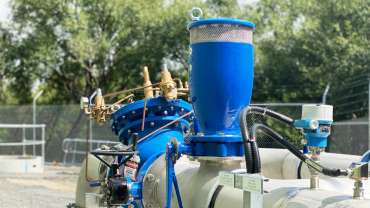Setting surge anticipation valves to protect pipelines from pressure surges
![100_2135 Two surge anticipation valves]()
Surge anticipation valves perform at their best when they’ re fitted for function. Learn how to correctly set your valve to suit the requirements of your pipeline or pumping station.
It is critical that if a surge anticipation valve is fitted to a pumping station, it must be set in accordance with the application. This article describes the optimal process to determining the set points of the valve.
The following video describes the operation of the surge anticipation valve:
Determining the set points
Prior to setting the valve, it is important to consult your local Bermad office to help your team determine the best set points for surge mitigation within a pipeline.
We suggest compiling the following data so Bermad can support your team to determine where the set points should be:
— What is the static head in the pipeline ?
— What is the running head in the pipeline ?
— What is the flow rate in the pipeline ?
— What is the pipe diameter ?
— What is the pipe material and class ?
— How long is the pipeline ?
— How quickly do the pumps start and stop ?
Understanding valve pilots
On the valve itself, there is a high – pressure pi lot that is designed to allow the valve’s top to open under high pressure. The second pilot is able to respond to low – pressure, and opens under low – pressure conditions. The following videos show this function in action:
Setting of the valve
Once you have clarified the set points of the pilots (based on the information you have shared with Bermad), you will now be able to follow instructions on how to set the pilots..
Another point of consideration is to set the mechanical flow stem within the valve to avoid water loss that could drain the pipeline.
Click this data link for a resource that describes the process required to set the pilots on a surge anticipation valve.
If you require further installation advice or input on how to set your surge anticipation valve, please do not hesitate to get in touch with the Bermad team today.
Make enquiry
Online Enquiry Close

Surge anticipation valves perform at their best when they’ re fitted for function. Learn how to correctly set your valve to suit the requirements of your pipeline or pumping station.
It is critical that if a surge anticipation valve is fitted to a pumping station, it must be set in accordance with the application. This article describes the optimal process to determining the set points of the valve.
The following video describes the operation of the surge anticipation valve:
Determining the set points
Prior to setting the valve, it is important to consult your local Bermad office to help your team determine the best set points for surge mitigation within a pipeline.
We suggest compiling the following data so Bermad can support your team to determine where the set points should be:
— What is the static head in the pipeline ?
— What is the running head in the pipeline ?
— What is the flow rate in the pipeline ?
— What is the pipe diameter ?
— What is the pipe material and class ?
— How long is the pipeline ?
— How quickly do the pumps start and stop ?
Understanding valve pilots
On the valve itself, there is a high – pressure pi lot that is designed to allow the valve’s top to open under high pressure. The second pilot is able to respond to low – pressure, and opens under low – pressure conditions. The following videos show this function in action:
Setting of the valve
Once you have clarified the set points of the pilots (based on the information you have shared with Bermad), you will now be able to follow instructions on how to set the pilots..
Another point of consideration is to set the mechanical flow stem within the valve to avoid water loss that could drain the pipeline.
Click this data link for a resource that describes the process required to set the pilots on a surge anticipation valve.
If you require further installation advice or input on how to set your surge anticipation valve, please do not hesitate to get in touch with the Bermad team today.



